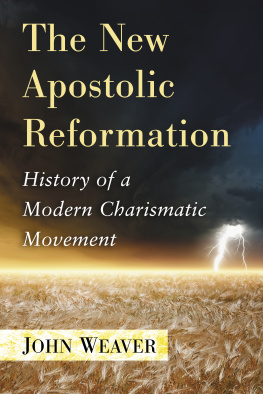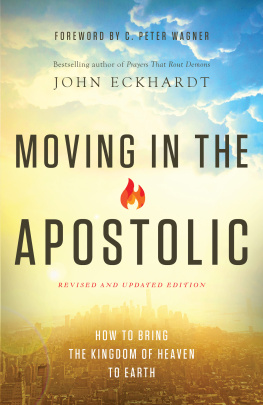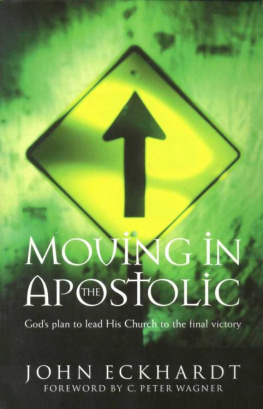
Also by JOHN WEAVER
The Failure of Evangelical Mental Health Care: Treatments That Harm Women, LGBT Persons and the Mentally Ill (McFarland, 2015)
Evangelicals and the Arts in Fiction: Portrayals of Tension in Non-Evangelical Works Since 1895 (McFarland, 2013)
The New Apostolic Reformation
History of a Modern Charismatic Movement
John Weaver

McFarland & Company, Inc., Publishers
Jefferson, North Carolina
LIBRARY OF CONGRESS CATALOGUING DATA ARE AVAILABLE
BRITISH LIBRARY CATALOGUING DATA ARE AVAILABLE
e-ISBN: 978-1-4766-2421-1
2016 John Weaver. All rights reserved
No part of this book may be reproduced or transmitted in any form or by any means, electronic or mechanical, including photocopying or recording, or by any information storage and retrieval system, without permission in writing from the publisher.
Front cover image 2016 Igor Zhuravlov
McFarland & Company, Inc., Publishers
Box 611, Jefferson, North Carolina 28640
www.mcfarlandpub.com
To William M. Barto, for inspiring my love of history.
You are missed.
To Rachel Weaver, who will always be my favorite sister.
And to David Weaver, in the hope that he will always be
the Last Frankenstein!
Acknowledgments
There are several people I wish to thank for help on this book. First, a big thanks must go out to Bruce Wilson and Rachel Tabachnick, who answered numerous questions over a period of many months. My friend Andrea Davis looked at an early stage of the manuscript and provided valuable comments. As always, thanks must go to Chelsea, Sean, Sarah, and Tanya, who provided the impetus for much of this research. Cindy Kunsman, as always, gave me both great feedback and good inside information on current happenings in the evangelical subculture. My friends Josh Lewis and Mikhail Gofman provided much needed encouragement, as did my former dissertation director Gayle Whittier. I also wish to thank Kathryn Joyce for commissioning an article on the Templeton Foundation toward the tail-end of this project. The article not only provided me with much needed funds for research, but also allowed me to finesse my understanding of the Foundations relationship with the NAR. Kathryns critique of my writing was also immensely useful; my style, to put it mildly, has always bordered on King James verbosity, and Kathryns suggestions on how to implement more concise arguments were wonderfully instructive. I also wish to thank my entire family for putting up with me over many months of writing and proofreading.
Preface
This book originated in an odd way. When I entered graduate school in 2006, I was unaware of the New Apostolic Reformation (NAR), despite specializing in evangelical studies. This lack of awareness was typical of many scholars during the period. The few scholars that had heard of this movement dismissed its existence as the product of left-wing paranoia, or alternately as a fringe group whose existence was largely confined to extremists like Becky Fischer, star of the expose Jesus Camp (2006). At the time I saw Jesus Camp, I dismissed the documentarys participants as a fringe movement.
Fast forward two and a half years. In the fall of 2008, I began blogging about a deliverance ministry called Mercy Ministries. Deliverance ministries are exorcism ministries that are ubiquitous throughout much of evangelical culture (particularly among Charismatics and Pentecostals) (see Cuneo 44). Mercy Ministries was among the worst examples of such exorcism practice in the West. As I have documented extensively in my book The Failure of Evangelical Mental Health Care: Treatments that Harm Women, LGBT Persons, and the Mentally Ill (2014), Mercy Ministries became notorious for its exorcism of mentally ill, sexually traumatized, and LGBT individuals (Weaver 95); so notorious was this ministry that it was expelled from Australia due to a massive public backlash, in which I played a part. My experience of researching Mercy Ministries eventually led me to the theoretical material undergirding their beliefs, including the exorcism manual Restoring the Foundations.
As I began researching for The Failure of Evangelical Mental Health Care, my research led me to connect the dots and see that Mercy Ministries was just a small cog in a network of churches, deliverance ministries, and apostolic networks that fall under the moniker of the NAR. The NAR is a movement dedicated to the restoration of the so-called fivefold gospel of Ephesians, in which the roles of apostles, and prophets in particular, are restored to the modern evangelical church. Given the movements Charismatic character, these roles are also accompanied by an increasing emphasis on the prophetic (words of knowledge) and on divine healing.
The NAR has promoted projects ranging from Operation Ice Castle, a 20,000-foot climb up Mount Everest to do territorial spiritual warfare against the Queen of Heaven demonic entity (Wagner, Confronting the Queen 37) to a call by one of its more conservative members, Rick Joyner, for a coup against President Obama (Rick Joyner Praying for Military Coup Over Obama). NAR apostle Kimberly Daniels, who was elected to the Jacksonville City Council, has promoted the idea that demonic curses can be transferred to children via trick-or-treating, and more seriously has advanced the antiSemitic notion that the Jews own everything. Another apostle in the movement, Jim Ammerman, promoted New World Order conspiracy theories (Daniels; Besen; Tabachnick, Col. Jim Ammerman). One of the leading apostles of the movement, Cindy Jacobs, has suggested that the mass deaths of some birds may be linked to the repeal of the militarys Dont Ask, Dont Tell policy (Mantyla, Jacobs: Birds Are Dying).
The average reader might be inclined to think that such extremism means that these figures cannot be taken seriously or do not represent the mainstream of a religious movement. Yet in the U.S. alone, if movement leader C. Peter Wagner is to be believed, the movement accounts for at least 8 to 10 million adherents (Wagner, Churchquake! 8). The larger Third Wave Pentecostal movement as a whole, of which the NAR is a large part, is estimated to have included over 295 million people worldwide as of 2000 (Synan 404). While not all Third Wavers fall into the new apostolic paradigm, it is undeniable that a large percentage of modern Charismatic churches do fit into that model. Some of the Charismatic movements most popular preachers, such as Mike Bickle, Bill Johnson and John Arnott, follow New Apostolic teachings (see Chapters 1 and 3 on this) and their views are no less extreme than those I have mentioned above. Indeed, Cindy Jacobs, Kimberly Daniels, and Rick Joyner all represent mainstream thought in the NAR. The NAR, more than any Charismatic or evangelical movement previous to it, is trying to reinsert supernatural agency into all spheres of American life, from politics to healthcare, and it is the movements quasi-magical theology that makes it a cause for concern.
Even for a former evangelical insider like myself, the beliefs of the NAR were so perplexing that after reading several books by movement authors and consulting the best source then available on the subject, Ren Holvasts Spiritual Mapping in the United States and Argentina 19892005: A Geography of Fear (2009), I was at a loss. I needed a tutor, one who could explain to me the inner workings of this new form of doing church.
Next page









